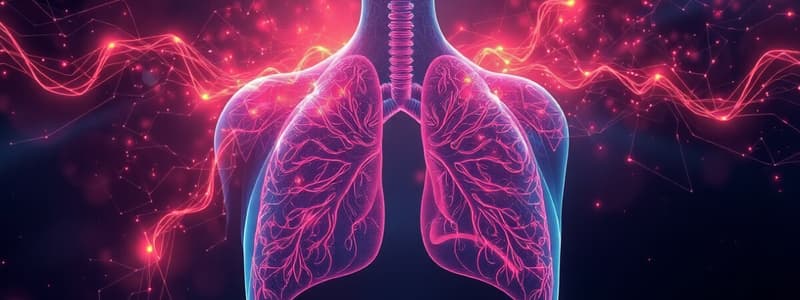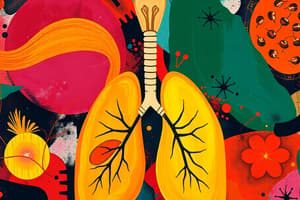Podcast
Questions and Answers
What primarily stimulates the dorsal respiratory group (DRG) during normal breathing?
What primarily stimulates the dorsal respiratory group (DRG) during normal breathing?
- Relaxation of respiratory muscles
- Contraction of diaphragm and external intercostal muscles (correct)
- Inhibition of lung distension
- Increased tidal volume
Which center in the pons inhibits inspiration?
Which center in the pons inhibits inspiration?
- Pneumotaxic center (correct)
- Ventral respiratory group
- Dorsal respiratory group
- Apneustic center
What is the main function of peripheral chemoreceptors?
What is the main function of peripheral chemoreceptors?
- Regulate the activity of the pneumotaxic center
- Respond directly to decreased PaO2 (correct)
- Detect changes in lung volume
- Monitor blood pH levels indirectly
What effect does decreased pH have on central chemoreceptors?
What effect does decreased pH have on central chemoreceptors?
Which of the following is NOT a type of mechanical sensor involved in breathing?
Which of the following is NOT a type of mechanical sensor involved in breathing?
What does the Hering-Breuer reflex primarily prevent?
What does the Hering-Breuer reflex primarily prevent?
What happens during intense breathing, such as during exercise?
What happens during intense breathing, such as during exercise?
Which pressures are primarily responsible for maintaining lung stability?
Which pressures are primarily responsible for maintaining lung stability?
What is transpulmonary pressure defined as?
What is transpulmonary pressure defined as?
Which of the following is NOT an importance of intrapleural pressure?
Which of the following is NOT an importance of intrapleural pressure?
Which muscle is primarily responsible for inspiration?
Which muscle is primarily responsible for inspiration?
What effect does the central nervous system have on breathing?
What effect does the central nervous system have on breathing?
Which of the following describes the Hering-Breuer reflex?
Which of the following describes the Hering-Breuer reflex?
What occurs during the process of inspiration?
What occurs during the process of inspiration?
How does chronic obstructive pulmonary disease (COPD) affect lung mechanoreceptors?
How does chronic obstructive pulmonary disease (COPD) affect lung mechanoreceptors?
What is a characteristic of Kussmaul breathing?
What is a characteristic of Kussmaul breathing?
Which muscle is considered the principal muscle of inspiration?
Which muscle is considered the principal muscle of inspiration?
Which type of chemoreceptors are sensitive to changes in arterial partial pressure of carbon dioxide (PCO2)?
Which type of chemoreceptors are sensitive to changes in arterial partial pressure of carbon dioxide (PCO2)?
How does expiration occur during quiet breathing?
How does expiration occur during quiet breathing?
What is the range of normal respiratory rates in adults?
What is the range of normal respiratory rates in adults?
What is the average intrapleural pressure in humans?
What is the average intrapleural pressure in humans?
Which of the following describes trans-pulmonary pressure?
Which of the following describes trans-pulmonary pressure?
Which muscles contract during forced expiration?
Which muscles contract during forced expiration?
What defines tachypnea?
What defines tachypnea?
Flashcards
Inspiration
Inspiration
The act of taking air into the lungs.
Expiration
Expiration
The act of breathing out.
Diaphragm
Diaphragm
Principal muscle of inspiration, increases vertical chest diameter.
External Intercostals
External Intercostals
Signup and view all the flashcards
Intra-alveolar Pressure
Intra-alveolar Pressure
Signup and view all the flashcards
Intrapleural Pressure
Intrapleural Pressure
Signup and view all the flashcards
Transpulmonary Pressure
Transpulmonary Pressure
Signup and view all the flashcards
Quiet Breathing
Quiet Breathing
Signup and view all the flashcards
Importance of Intrapleural Pressure
Importance of Intrapleural Pressure
Signup and view all the flashcards
Respiratory Control
Respiratory Control
Signup and view all the flashcards
Respiratory Muscles
Respiratory Muscles
Signup and view all the flashcards
Chemoreceptors
Chemoreceptors
Signup and view all the flashcards
Hering-Breuer reflex
Hering-Breuer reflex
Signup and view all the flashcards
Breathing abnormalities (e.g., Kussmaul, Cheyne-Stokes, Biot)
Breathing abnormalities (e.g., Kussmaul, Cheyne-Stokes, Biot)
Signup and view all the flashcards
Dorsal Respiratory Group (DRG)
Dorsal Respiratory Group (DRG)
Signup and view all the flashcards
Ventral Respiratory Group (VRG)
Ventral Respiratory Group (VRG)
Signup and view all the flashcards
Pneumotaxic Center (PNC)
Pneumotaxic Center (PNC)
Signup and view all the flashcards
Apneustic Center (APC)
Apneustic Center (APC)
Signup and view all the flashcards
Peripheral Chemoreceptors
Peripheral Chemoreceptors
Signup and view all the flashcards
Central Chemoreceptors
Central Chemoreceptors
Signup and view all the flashcards
Pulmonary Stretch Receptors
Pulmonary Stretch Receptors
Signup and view all the flashcards
Study Notes
Mechanics of Respiration I
- This presentation covers the mechanics of breathing.
- Learning Objectives include describing the functions of inspiration and expiration muscles, explaining inspiration and expiration processes, defining and describing the importance of intra-alveolar, intrapleural, and transpulmonary pressures.
- Breathing is a mechanical process for moving air in and out of the lungs.
- Respiratory rate is 12-20 breaths per minute.
Breathing Movements
- The body uses thoracic cavity muscles to change the volume of the chest.
- This alters pressure inside the lungs.
- An increase in volume = a decrease in pressure (and vice versa).
Basics of the Respiratory System
- Diagrams show the muscles and membranes involved in respiration. Images include the diaphragm, sternocleidomastoids, scalenes, and intercostals (internal and external).
Muscles of Inspiration
- The diaphragm is the principal inspiratory muscle.
- During inspiration, it contracts and increases the vertical diameter of the thoracic cage.
- External intercostals move the ribs, increasing both the transverse and anteroposterior diameters of the chest.
- Inspiration is an active process.
Muscles of Expiration
- Expiration is a passive process during quiet breathing, brought about by relaxation of inspiratory muscles.
- During forced expiration (coughing, blowing), expiration muscles (abdominal muscles and internal intercostals) contract to reduce thoracic cage volume.
- Contraction of abdominal muscles increases intra-abdominal pressure, pushing the diaphragm upward.
- Internal intercostals contract, pulling ribs downwards, further decreasing the chest size.
Lung Pressures
- Intrapulmonary pressure (intra-alveolar) measures pressure within alveoli.
- Normal range is -1 to +1 mm Hg, with 0 mmHg corresponding to atmospheric pressure.
- Intrapleural pressure is the pressure in the intrapleural space. Typical range is -6 to -3 mmHg.
- Average intrapleural pressure is -4 mmHg, which is always negative.
- Transpulmonary pressure is the pressure difference across the wall of the lung. It's always positive.
- This difference prevents lung collapse.
Importance of Intrapleural Pressure
- Helps inflate the lungs during inspiration.
- Prevents lung collapse.
- Decreases the work required for breathing.
- Aids venous and lymphatic drainage.
Regulation of Respiration
- Learning objectives include explaining the importance of breath control, outlining how the central nervous system controls breathing, listing anatomical locations of ventilation control chemoreceptors, describing the Hering-Breuer reflex, and chronic obstructive pulmonary disease (COPD) effects on lung mechanoreceptors, and defining breathing patterns (Kussmaul, Cheyne-Stokes, and Biot).
Case Presentation
- Patient GB is brought to an emergency department with altered mental status, history of illicit drug use, decreased respiratory rate, irregular breathing and episodes of apnea.
- Given the presentation, the reason for the abnormally deep breathing must be determined.
Why is Breath Control Important?
- Breathing is mostly an involuntary process.
- Respiratory muscles (diaphragm, intercostals, and abdominal muscles) receive signals from the brainstem (pons and medulla).
- Some voluntary control like breathing in activities (swimming, singing, yoga) exists.
How Does the Central Nervous System Control Breathing?
- Each brain region has specific neuronal groups for respiration.
- Medulla and pons stimulate respiratory muscles.
- Diagram of brain regions (medulla oblongata, pons, midbrain) is shown.
Medulla
- Dorsal Respiratory Group (DRG) controls inspiration and sets the normal breathing rhythm.
- Efferent DRG sends impulses via phrenic and intercostal nerves to stimulate inspiration by contracting the diaphragm and external intercostal muscles.
- Ventral Respiratory Group (VRG) is inactive during normal breathing but stimulates forced inhalation and exhalation in intense situations like exercise or illness.
Pons
- Pneumotaxic Center (PNC): located in the upper pons, inhibits inspiration by decreasing tidal volume and respiratory rate.
- Apneustic Center (APC) in lower pons stimulates inspiration, leading to deep gasping inspirations with occasional expirations.
What Chemical Sensors Control Breathing?
- Peripheral chemoreceptors detect decreased PaO2, increased PaCO2, and increased hydrogen ion concentration.
- They send impulses to the solitary nucleus in the brainstem for initiating inspiration.
- Decreased PaO2 is the primary and most important signal detected by peripheral chemoreceptors.
Central Chemoreceptors
- Located in the brain (ventral medulla).
- Sensitive to decreased pH of cerebrospinal fluid (CSF): acidic pH.
- This decreased pH stimulates central chemoreceptors to increase respiratory rate and tidal volume.
- Peripheral chemoreceptors are affected directly by low blood PaO2, high PaCO2, and low blood pH.
- Central chemoreceptors are affected indirectly by high PaCO2.
What Mechanical Sensors Control Breathing?
- Sensory receptors detect mechanical pressure or distortion.
- These include pulmonary stretch receptors, irritant receptors, and J receptors.
Pulmonary Stretch Receptors
- Stimulated by lung distension during inspiration.
- Send impulses via the vagus nerve to inhibit inspiration and prevent overinflation of the lungs.
- Typically not active at low tidal volumes, but importantly affect patients with COPD, a respiratory condition causing trapped air and increased lung volume/distension, therefore the reflex is diminished.
Irritant Receptors
- Found in upper respiratory airways (trachea, bronchi).
- Respond to mechanical and chemical irritants (chemicals, dust, pollens, cold air).
- Initiates coughing and bronchoconstriction for clearing harmful substances.
J Receptors
- Located near capillaries in alveolar septa.
- Sensitive to increased pulmonary capillary pressure.
- Initiates rapid, shallow breathing when stimulated.
- Important in conditions like heart failure with pulmonary edema and pulmonary emboli.
Mechanical Receptors that Control Breathing
- Pulmonary stretch receptors, irritant receptors, and J receptors (summary). Their stimuli and responses are listed.
What Are Some Pathological Breathing Patterns?
- Kussmaul, Cheyne-Stokes, and Biot breathing illustrated in a graph.
Case Connection
- GB's history and Biot breathing pattern are suggestive of opioid overdose.
- Opioid intoxication can cause respiratory arrest, and is reversed with an opioid receptor antagonist (naloxone).
Studying That Suits You
Use AI to generate personalized quizzes and flashcards to suit your learning preferences.




